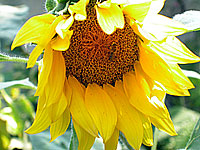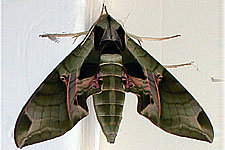 Mostly the worker bees from both colonies, Wilde and Twain, take off straight up into the air, and it's impossible to trace where they are headed. Walking around the neighborhood, it is rare indeed to see a honeybee at work. Except lately.
Mostly the worker bees from both colonies, Wilde and Twain, take off straight up into the air, and it's impossible to trace where they are headed. Walking around the neighborhood, it is rare indeed to see a honeybee at work. Except lately.We seem to be in a special middle interlude of summer right now. Earlier in the year, there were lots of tiny flowers blooming at the tree level: buds for fruits and seeds, in the hundreds of thousands really, far above our heads where we don't usually think about critter life taking place (plus or minus the odd bird song). The bees were up there, busily out of sight. Soon, the crape myrtles will truly take over for a few weeks, into early August. They look like tall, tree-like lilacs, but their blooms can range from white and light pink all the way to purple.
But right now, most of the blooms to be had are at eye level. Some, literally so, like this sunflower that was planted by the birds. My disorganized back garden has a crazy row of the things: once in Mexico they told us that the corn plant was considered a gift from the gods, so to this day Maya landscape workers often refuse to cut misplaced volunteers when mowing grass or road margins. You can go down a road and see one tall corn plant standing by itself, tassles and all. I feel that way about the sunflowers.
The birds dropped these seeds when flying away from the feeders last winter, and bees of all kinds have been frequent visitors. Every seed in a sunflower is a result of an individual pollinator visit, so there is plenty of work to go around. It seems like dozens of different bees, butterflies, (funky) wasps, yellow jackets, and unclassifiables have been visible at every time of the day. It is hard to see the bee in the sunflower above, because her golden body with deep brown stripes is a great fit for that blossom.
 Also filed under "glad I hate to weed" is the wild grape vine that has been allowed to climb the garden wall. The plant is a nasty invasive, eating entire forests around here, but last year it yielded an unusual visitor. A moth the size of a Cessna flew into the house late one night, literally causing me to duck under a couch cushion. It appears to be a "blinded sphinx," and it likes to lay its eggs on the wild grape vine. So I didn't pull the vine this year. The flowers were never very noticeable before, but yesterday the entire vine was covered in honeybees as well as natives, making quick work of the thousands of tiny blooms that this prolific reproducer keeps on hand. My work is probably cut out for me, if I want anything else at all to be growing in that garden next year, but my neighbors on the other side just planted something worse: bamboo. Perhaps this is nature's way of meeting an irresistible force with an immovable object.
Also filed under "glad I hate to weed" is the wild grape vine that has been allowed to climb the garden wall. The plant is a nasty invasive, eating entire forests around here, but last year it yielded an unusual visitor. A moth the size of a Cessna flew into the house late one night, literally causing me to duck under a couch cushion. It appears to be a "blinded sphinx," and it likes to lay its eggs on the wild grape vine. So I didn't pull the vine this year. The flowers were never very noticeable before, but yesterday the entire vine was covered in honeybees as well as natives, making quick work of the thousands of tiny blooms that this prolific reproducer keeps on hand. My work is probably cut out for me, if I want anything else at all to be growing in that garden next year, but my neighbors on the other side just planted something worse: bamboo. Perhaps this is nature's way of meeting an irresistible force with an immovable object.
No comments:
Post a Comment